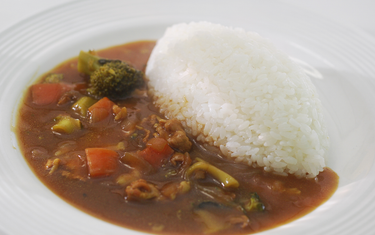In Japan, rice is a staple food and we have a wide variety of rice dishes.
Even for sushi, one of traditional Japanese food, we have several types such as nigirizushi (hand-shaped sushi), sushi roll, and oshizushi (pressed sushi).
We have even more ― in Japanese style, Gyudon (beef rice bowl), Tendon (Tempura rice bowl), Katsudon (Tonkatsu rice bowl), Teishoku (rice set meal), and in Western style curry rice, omelette rice, etc.
What is more interesting is that molding rice is common and familiar in Japanese food culture.
Restaurants often serve molded rice, in sushi, curry rice, omelette rice, etc.
We would like to show you those professional-use rice molds.
What are Rice Molds Like?

A rice mold is a metal mold to shape rice. We will show you 2 different ones, melon-shaped mold and chrysanthemum-shaped mold. Both are commonly used in restaurants though it’s rare to see those used at home.
These rice molds are often used at western cuisine restaurants in Japan, mainly for curry rice or omelette rice, in order to make them look better as well as keep rice warm.
Especially when cooking omelette rice, it takes some more time to cook omelette after rice. It can prevent the rice getting cold to put it in a rice mold in the meantime.
How to Use Rice Molds

Using rice molds is very easy and simple.

Fill rice in a mold and flip it upside down onto a platter. That’s it!
Rice molds are very useful when you serve a plate lunch or make the dishes more photogenic for SNS posts. Of course, this isn’t their only functionality, and we should also be aware of another practical functionality to retain heat.
These molds are made of aluminum, which features high heat conductivity and good heat retaining function. However, materials with high heat conductivity are also quick to cool down. So, it is important to complete dishes while the rice is warm.

With the chrysanthemum-shaped mold, the rice is shaped like this. The more rice is filled in, the more exactly it will be shaped as the mold is. However, be careful not to fill too much rice, otherwise the rice will lose good flavor and soft texture.
This mold can be used for Indian curry, plate lunch, or kids’ lunch.

With the melon-shaped mold, the rice is shaped like this. This shape is common mainly for omelette rice or Japanese style curry rice. Beautifully shaped rice gives us impression of sophistication or elegance as if we eat it at good restaurants.

Let's try using rice molds and upgrade your daily meals or occasional special meals!













